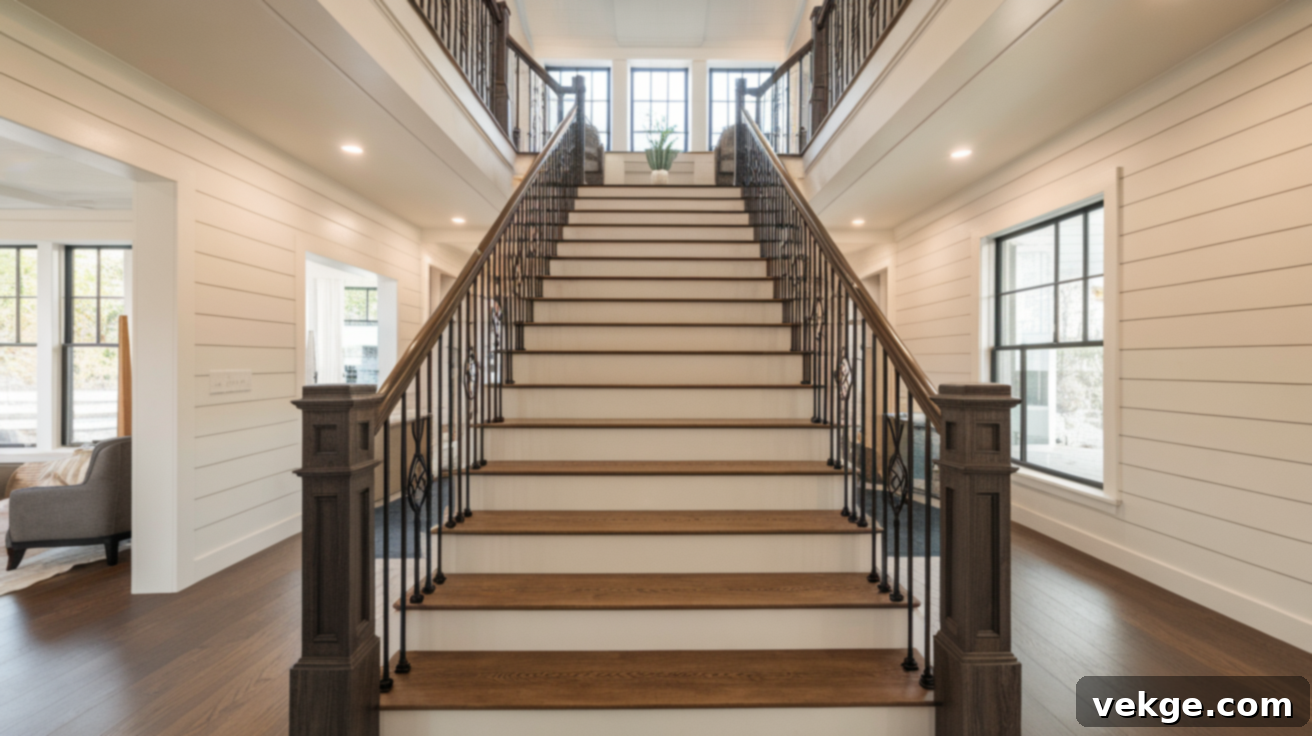Transform Your Home: 20+ Stunning Dark Wood Stairs with White Risers Ideas & DIY Guide
Imagine stepping into your home and being greeted by a staircase that instantly captivates. Some staircases don’t just lead you up or down; they stop you in your tracks, becoming an architectural masterpiece in their own right. This is especially true when the deep, rich tones of dark wood steps meet the crisp, clean lines of white risers. This powerful combination isn’t just a fleeting trend; it’s a timeless design choice that creates a striking contrast, clean lines, and a style that feels both boldly contemporary and comfortably classic.
If your current staircase feels like an afterthought, blending into the background rather than making a statement, this classic mix of dark wood and white offers a transformative solution without the need for a full-scale renovation. In this comprehensive guide, we’ll dive deep into smart, achievable ideas for updating your staircase using this enduring and elegant combo. Whether you’re aiming for a subtle refresh or a dramatic overhaul, you’ll find inspiration tailored to various aesthetics and spaces, proving that a simple change can yield a profound impact.
We’ll journey through a diverse collection of styles, from simple designs perfectly suited for cozy nooks to grand, expansive looks that command attention in wide entryways, and everything in between. Beyond inspiration, this article equips you with practical knowledge. You’ll also receive a detailed, step-by-step DIY guide complete with a list of essential tools, clear instructions, and expert tips to empower you to tackle this project yourself, even if you’re a first-time DIYer. Get ready to elevate your home’s aesthetic and make those stairs truly stand out as a central feature!
Why Choose Dark Wood Stairs with White Risers for Your Home?
The enduring popularity of dark wood stairs paired with white risers isn’t just about aesthetics; it’s about the unique blend of benefits this combination offers. This high-contrast pairing creates an eye-catching focal point that immediately elevates your staircase from a functional element to a design statement. The deep, warm hues of the dark wood treads provide a sense of grounding and sophistication, anchoring the space with natural elegance. Simultaneously, the bright white risers introduce an element of lightness and airiness, preventing the dark wood from feeling too heavy or overwhelming. This harmonious balance makes the staircase feel both grand and inviting, welcoming you home with every step.
This classic mix has remained a perennial favorite in interior design for decades because of its incredible versatility. It seamlessly integrates with virtually any home style, from rustic farmhouses and traditional estates to sleek modern lofts and minimalist dwellings. The stark contrast itself becomes a design feature, complementing various color palettes and material choices throughout your home, ensuring a cohesive and polished look regardless of your interior theme.
Beyond its aesthetic appeal, this combination also offers practical advantages. Dark wood treads tend to show less dirt, dust, and minor scuffs than lighter wood floors, making them relatively easy to maintain in high-traffic areas. This means less frequent deep cleaning and more time enjoying your beautiful stairs. However, it’s worth noting that the white risers, while brightening the space, may require more frequent wiping to maintain their pristine appearance and prevent scuff marks from shoes. Despite this minor upkeep, the overall visual impact, lasting appeal, and ease of cleaning for the majority of the surface make it a worthwhile choice for homeowners seeking both stunning beauty and everyday functionality.
Elevate Your Entryway: Stylish Dark Wood Stairs with White Risers Ideas
The dynamic interplay of dark wood treads and crisp white risers creates a visually stunning focal point in any home. This iconic duo effortlessly injects warmth, sophistication, and brightness into your living space, making it a design choice that not only fits almost any architectural style but also makes a powerful, unforgettable statement. Let’s explore some inspiring ways to implement this timeless combination, transforming your staircase into a true highlight of your home:
1. Modern Farmhouse with Wrought Iron Rails
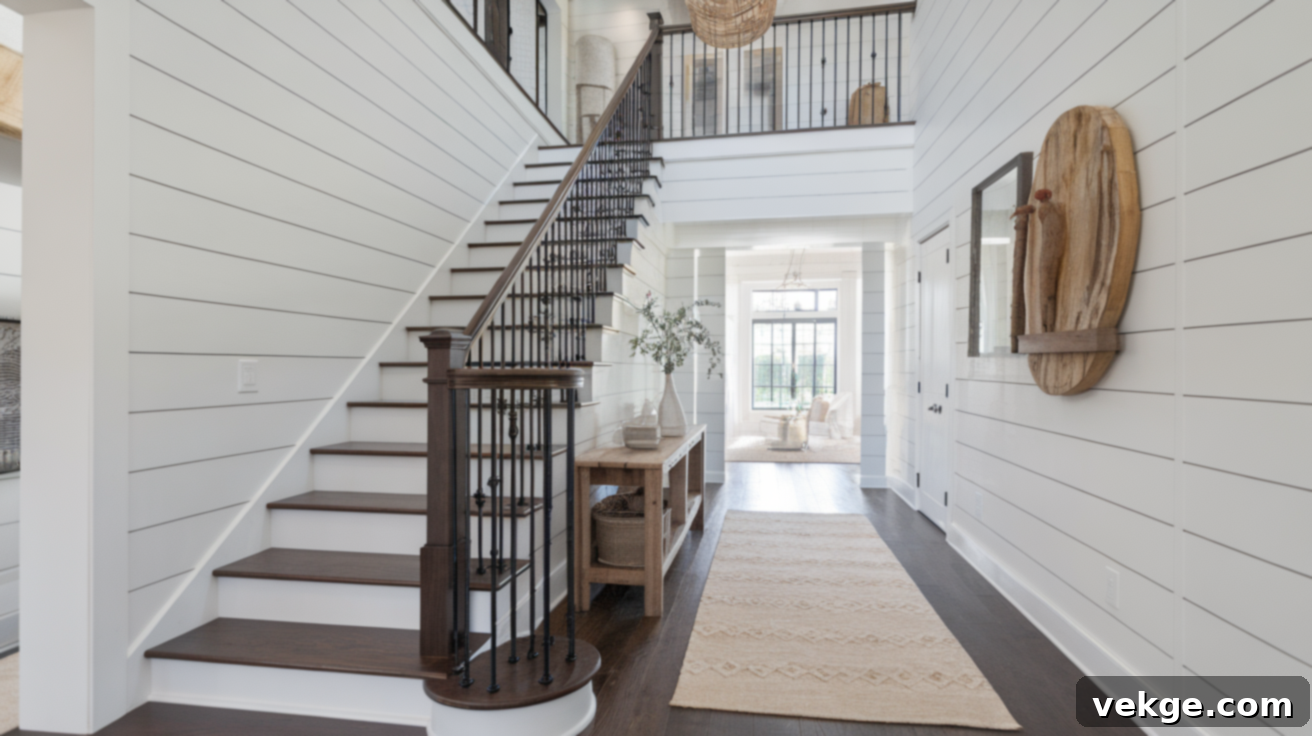
Achieve a captivating blend of rustic charm and contemporary elegance by pairing dark-stained wooden steps with clean white risers and sturdy black wrought iron balusters. This design beautifully marries the comfort of country living with a modern edge, making it an ideal choice for a wide array of home aesthetics. The deep, rich tone of the wood treads grounds the space and adds inviting warmth, while the bright white risers maintain an open, airy feel. The addition of black iron balusters introduces a touch of industrial strength and visual interest, creating a bold yet understated look. This combination is perfect for homeowners who desire a staircase that is both classic and distinctly stylish, avoiding any sense of being mundane and instead offering a sophisticated, welcoming pathway.
2. Floating Dark Wood Stairs
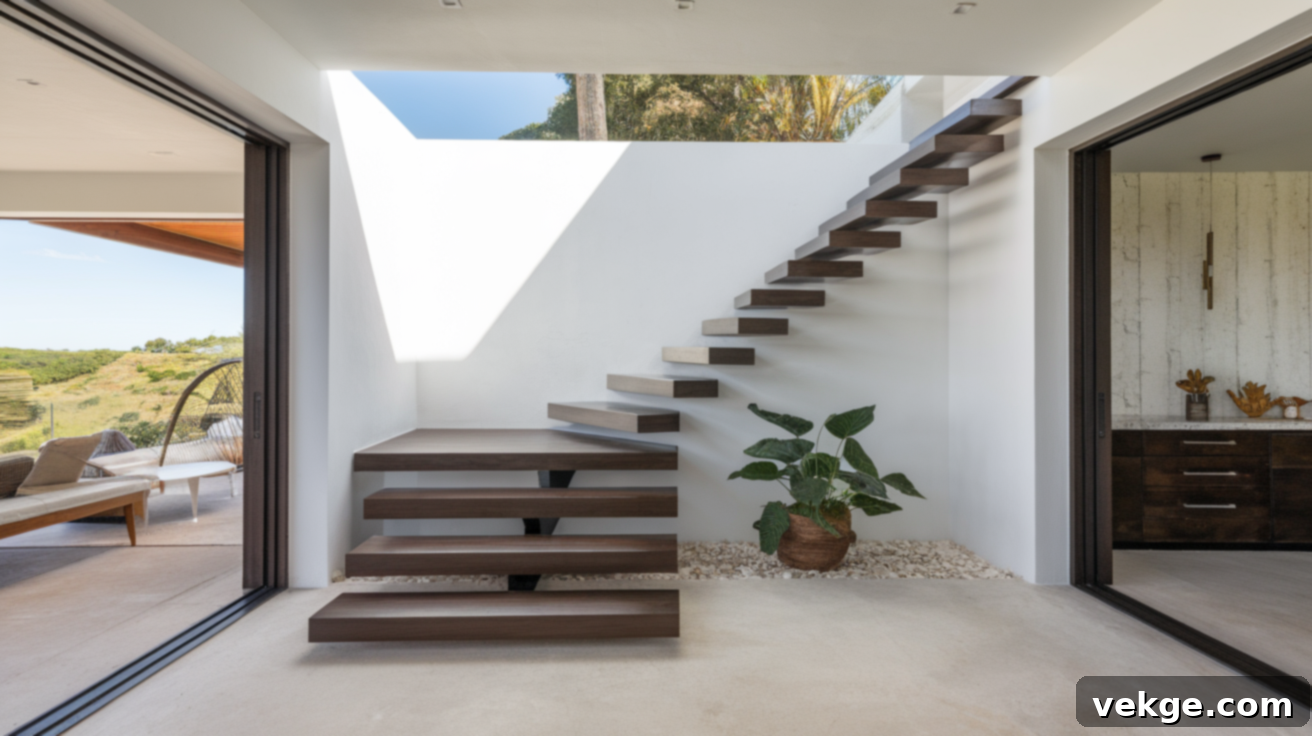
For a truly contemporary and airy feel, consider floating dark wood stairs. These architectural marvels appear to defy gravity, with each dark wood tread seemingly suspended in mid-air. When combined with minimalist white risers (or often, no visible risers at all, making the white wall behind them act as the contrast), they create a striking visual against a clean white wall. This design choice is particularly effective in making smaller spaces feel significantly larger and more open, as light can freely pass through the open areas between the treads, illuminating hallways and entryways. The clean, unencumbered lines of floating stairs exude a simple yet fresh aesthetic, perfectly suited for modern homes or places where a sense of spaciousness, light, and sleek design is paramount, offering an immediate “wow” factor.
3. Traditional Staircase with White Spindles
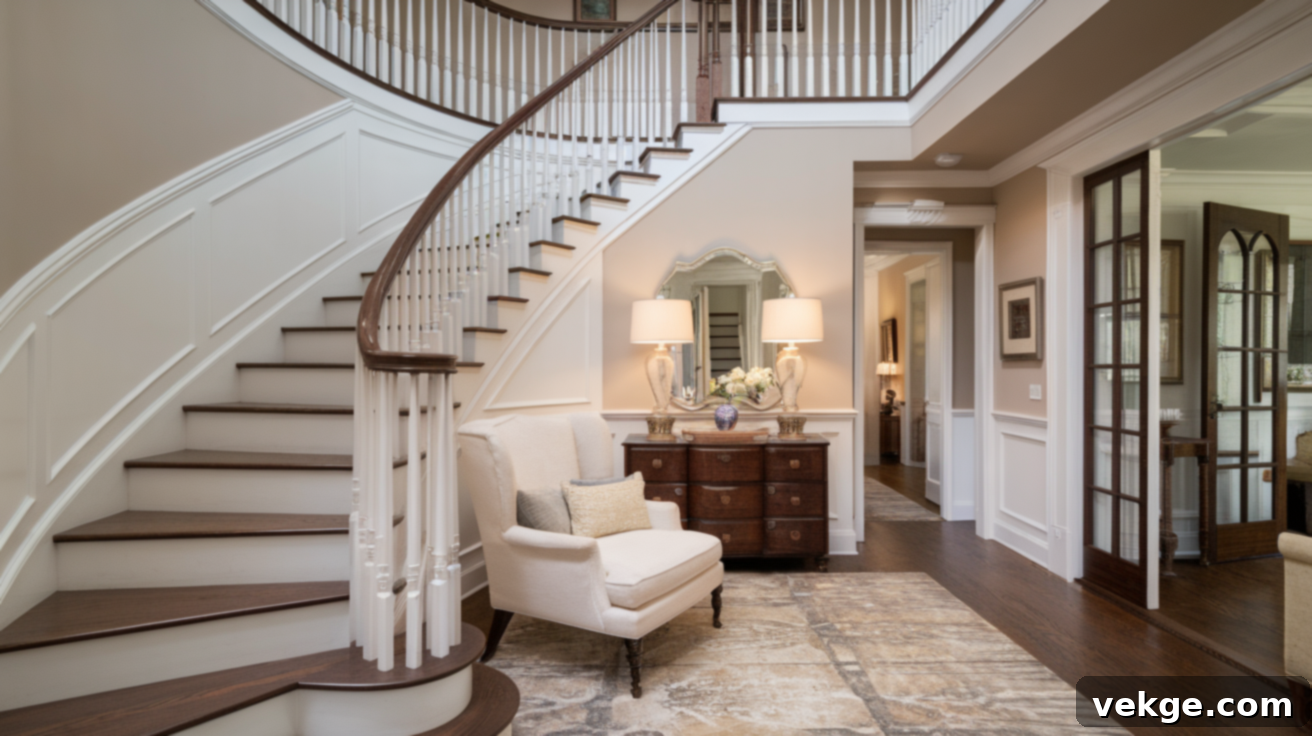
Embrace timeless elegance with dark oak steps complemented by classic white spindles and risers. This combination offers an enduring look that never goes out of style, making it a perfect fit for family homes, colonial-style houses, and traditional interiors. The pristine white spindles (or balusters) provide a visual lightness, preventing the staircase from appearing too heavy or imposing, while the rich, dark treads infuse the space with a deep sense of class and heritage. This harmonious blend brings a calm, refined, and beautifully composed feel to your entryway, creating an inviting and safe passage. It’s a design choice that homeowners will appreciate for its lasting beauty and widespread appeal for years to come.
4. Classic Mission Style Staircase
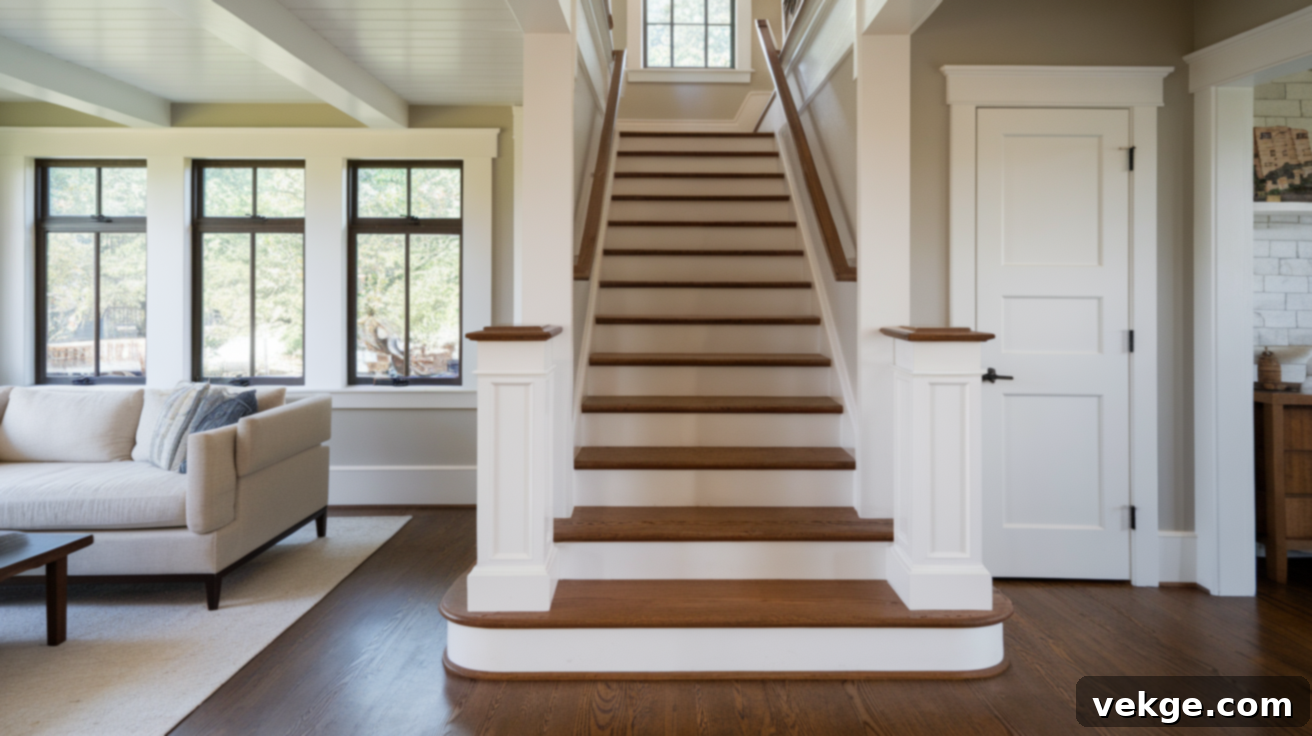
The Mission style is renowned for its straightforward beauty and robust construction. This design incorporates thick, substantial dark wood treads, plain white risers, and simple, often square or rectangular, balusters and newel posts. The emphasis on clean lines and fundamental geometric shapes imparts a sense of calm, stability, and unpretentious elegance. The white risers are crucial here, helping to reflect light and brighten the space, which is especially beneficial given the substantial dark wood elements. Rooted in early 20th-century design, this style remains remarkably relevant in contemporary homes, offering a blend of historical charm and modern simplicity. Its uncomplicated forms also make it exceptionally easy to clean and maintain, a significant advantage for bustling households seeking both durability and classic appeal.
5. Under-Stair Storage Drawers
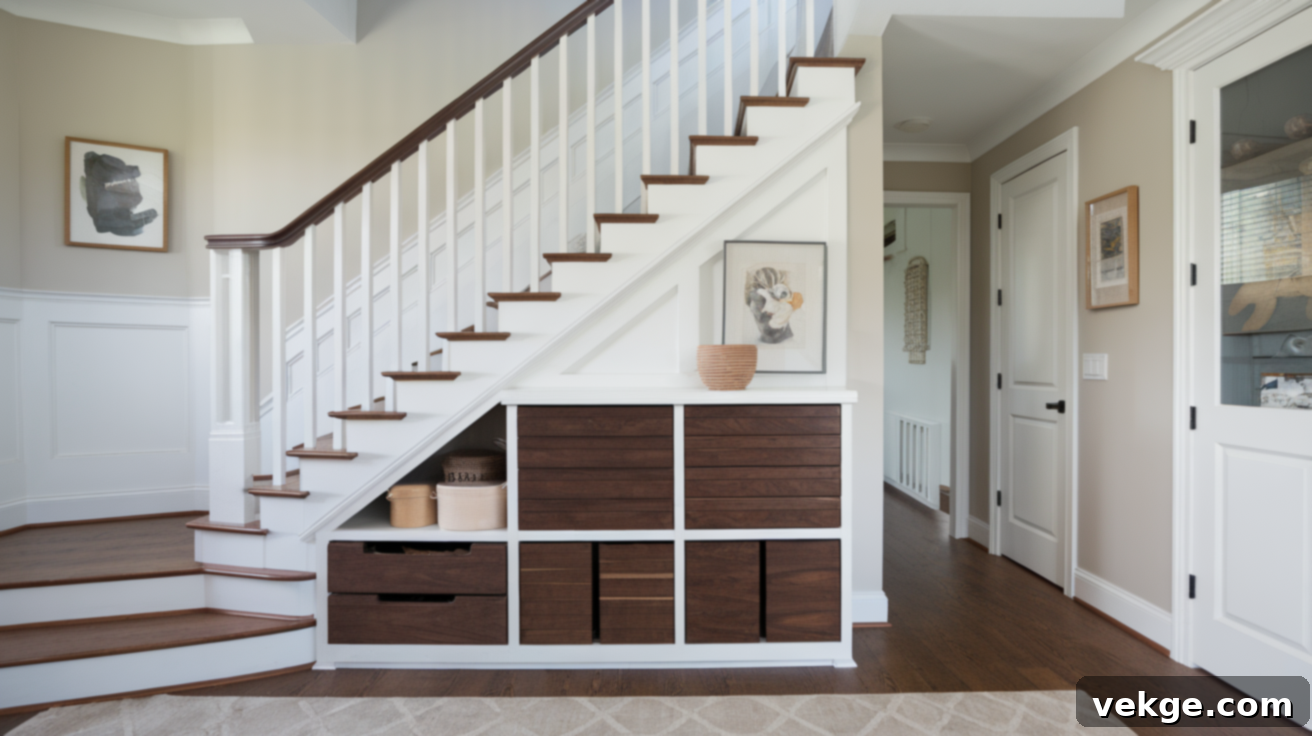
Maximize functionality without sacrificing style by integrating sleek white pull-out drawers directly into the risers beneath your dark wood stairs. These discreet storage solutions provide an invaluable place to neatly tuck away everyday clutter such as shoes, gloves, scarves, or children’s toys, keeping your entryway pristine and organized. The white drawer fronts are designed to seamlessly blend with the existing white risers, maintaining the continuity of the bright contrast. Meanwhile, dark wood accents or pulls on the drawer fronts can echo the treads, tying the design together beautifully. This ingenious use of often-wasted space is particularly effective in smaller homes or apartments where every square inch of storage is precious, offering both sophisticated aesthetic appeal and unparalleled practical utility.
6. Minimalist Black and White Combo
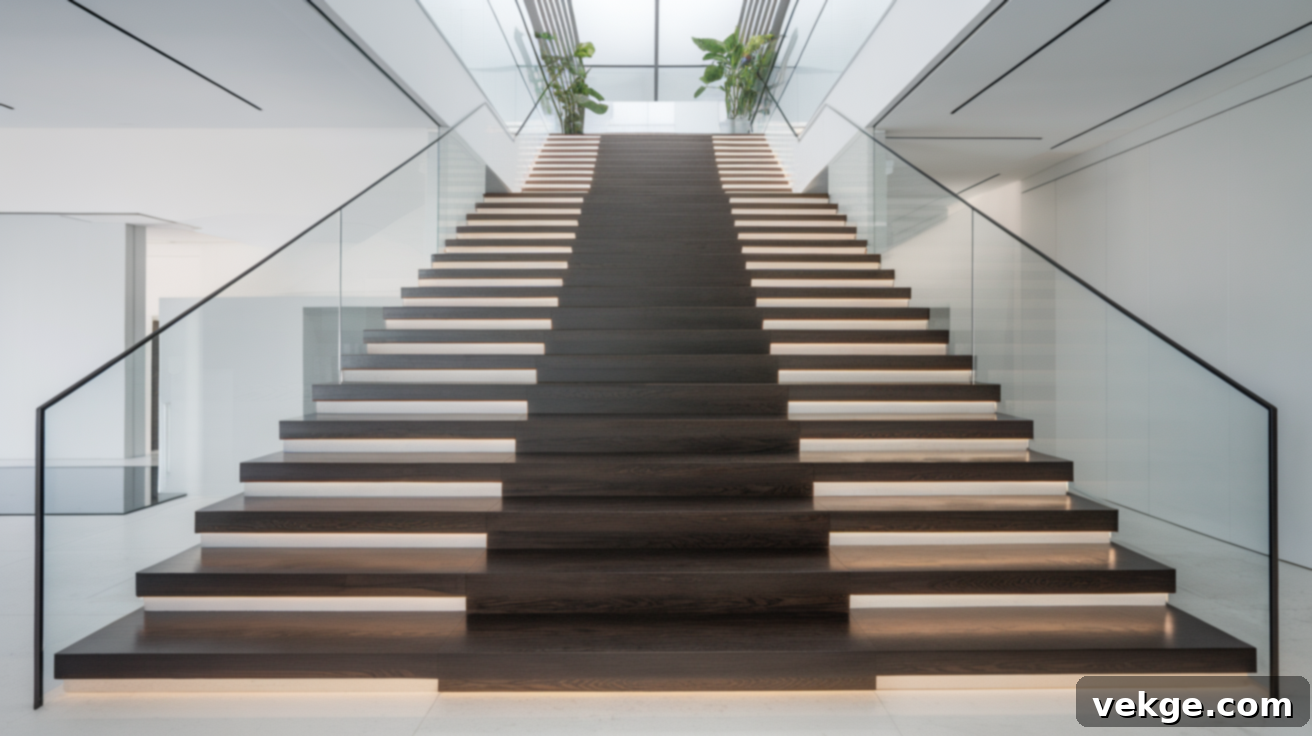
For those who embrace extreme simplicity and bold statements, a minimalist black and white staircase offers a striking aesthetic. Stain the wooden treads a very dark shade, almost black, and pair them with brilliant white risers. To amplify the minimalist impact, consider omitting a traditional railing altogether (where safety permits and codes allow, typically in adult-only spaces or specific architectural contexts), or opt for a very subtle, transparent railing. This stark, high-contrast palette is perfectly suited for ultra-modern homes characterized by clean lines, open spaces, and minimal decorative elements. The dramatic contrast creates an undeniable focal point without any unnecessary ornamentation, embodying a chic, fuss-free sophistication. While perhaps not ideal for homes with young children needing robust railings, it excels in adult-oriented, contemporary environments, making a powerful, artistic statement.
7. Scandinavian-Inspired Simplicity
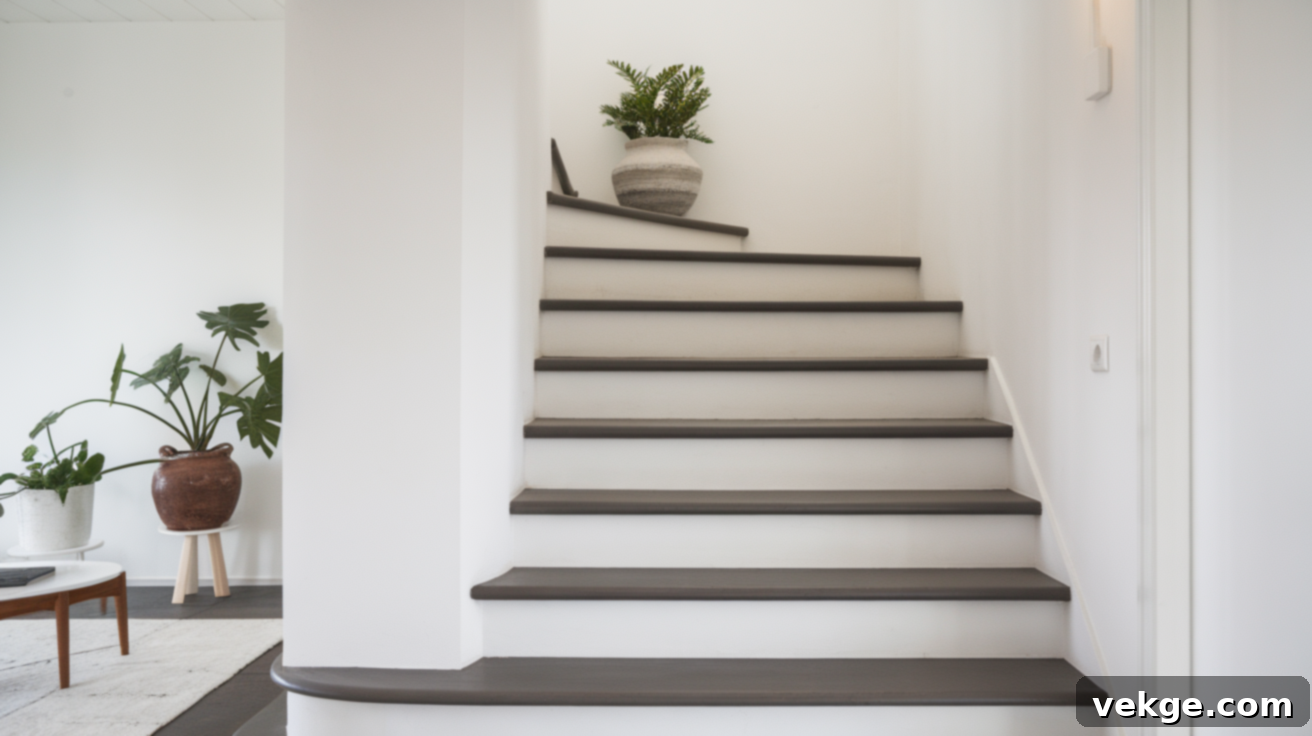
Drawing inspiration from Nordic design, this style emphasizes understated elegance and natural light. Opt for matte, non-glossy dark-stained wood treads, coupled with crisp white risers and an uncluttered white wall alongside. This clean, functional, and no-fuss approach evokes the warmth and brightness characteristic of Scandinavian interiors, which are often designed to combat long, dark winters by maximizing light. The dark treads provide a solid, grounding presence in the space, while the abundant white elements (risers and walls) actively work to open up and illuminate the area. This style is defined by its thoughtful simplicity, using a limited palette and few elaborate components to create a cohesive and exceptionally well-planned aesthetic. It is an excellent choice for homes that favor a minimalist lifestyle and an uncluttered, serene environment.
8. Shiplap Walls and Contrast Stairs
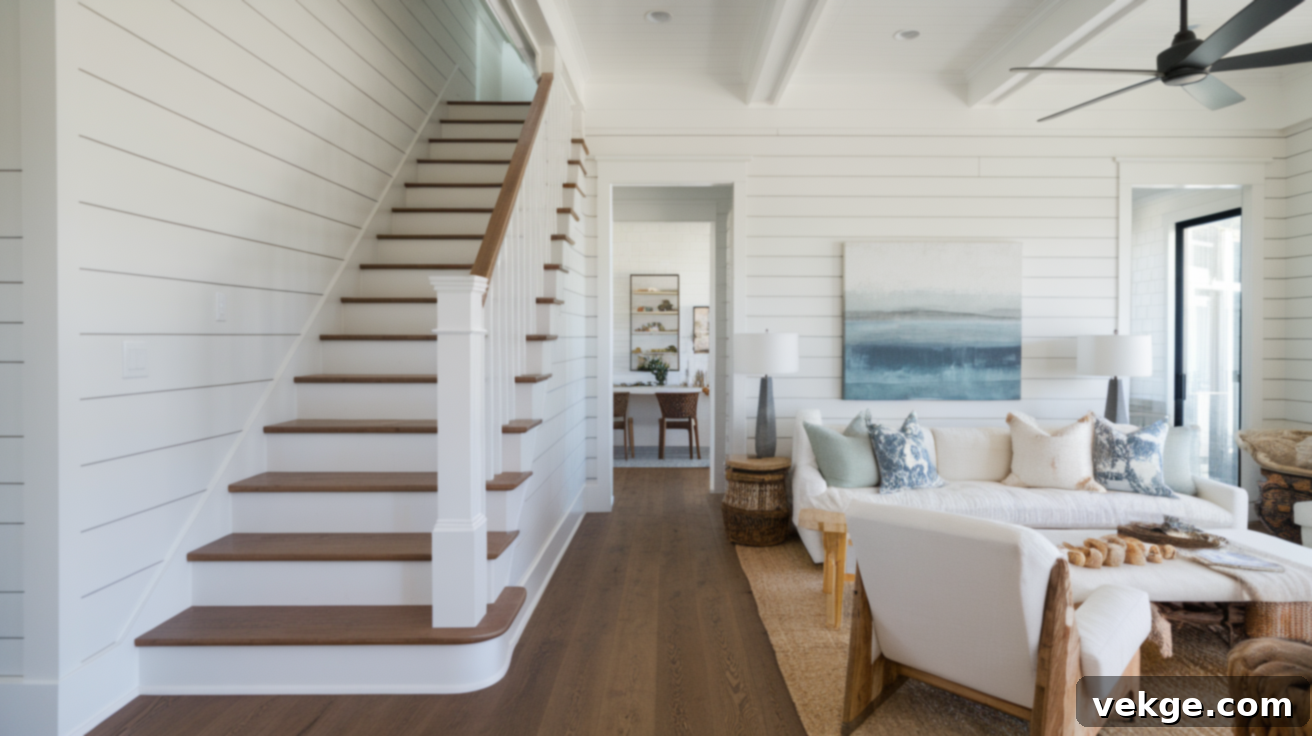
Enhance the visual impact of your dark wood and white staircase by introducing white shiplap paneling on the adjacent walls. The horizontal lines of the shiplap create a subtle yet engaging texture, adding depth and architectural interest without introducing additional colors or patterns. This design choice beautifully accentuates the dark treads, making them “pop” even more against the bright, textured backdrop. The unified white of the shiplap walls and stair risers works in concert to amplify the brightness and openness of the space, allowing the deep tones of the steps to truly shine. This style evokes a relaxed, coastal, or modern farmhouse ambiance, delivering a calm, clean, and highly stylish aesthetic to your home that feels both inviting and refined.
9. Glass Railing with Dark Stairs
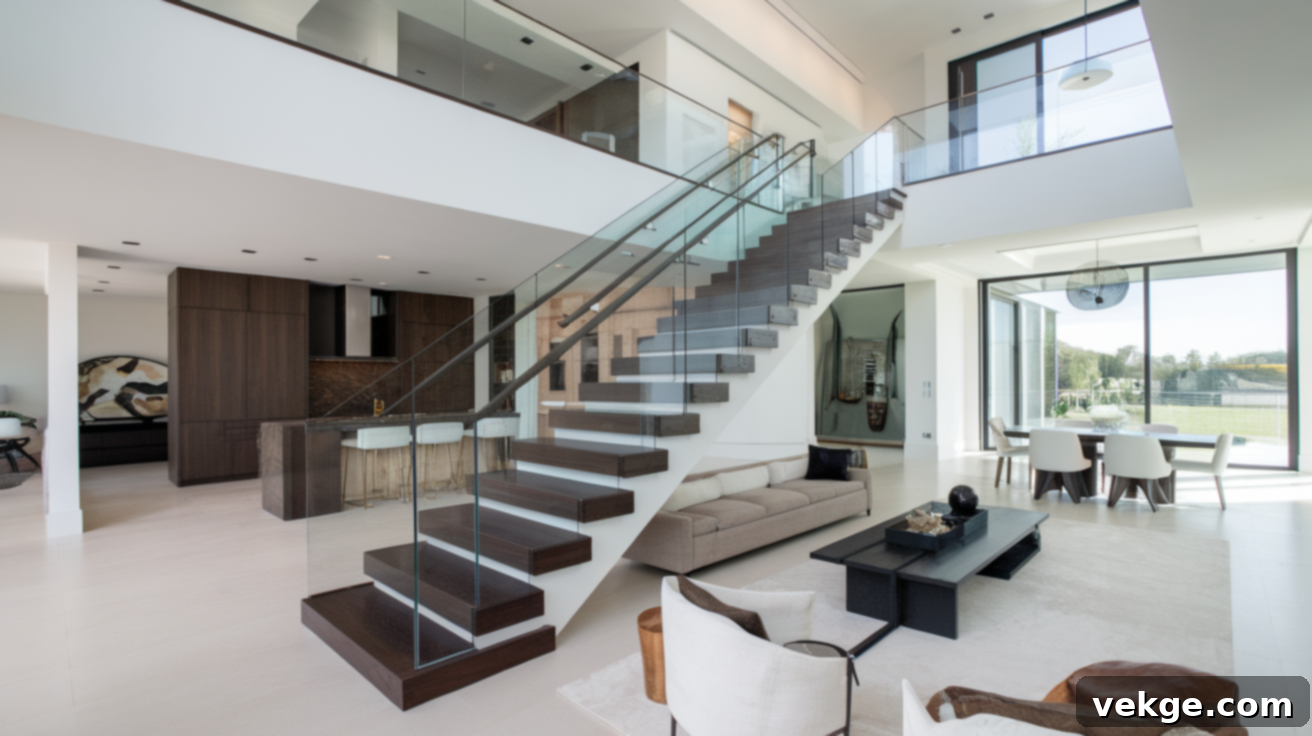
For an ultra-modern and sophisticated look, combine dark wood treads and pristine white risers with a sleek, frameless glass railing. This contemporary design maximizes light flow and maintains an open, expansive view across different areas of your home. The transparent glass panels offer a secure barrier without obstructing the visual appeal of the dark wood treads or the crisp white risers, allowing their beauty to be fully appreciated. Light passes effortlessly through the glass, which is particularly beneficial in making smaller or more confined spaces feel larger and more connected. This cutting-edge style is an ideal match for newer homes featuring open-concept floor plans, where seamless transitions and abundant natural light are key design principles, creating a truly luxurious and airy atmosphere.
10. Vintage Style with Turned Balusters
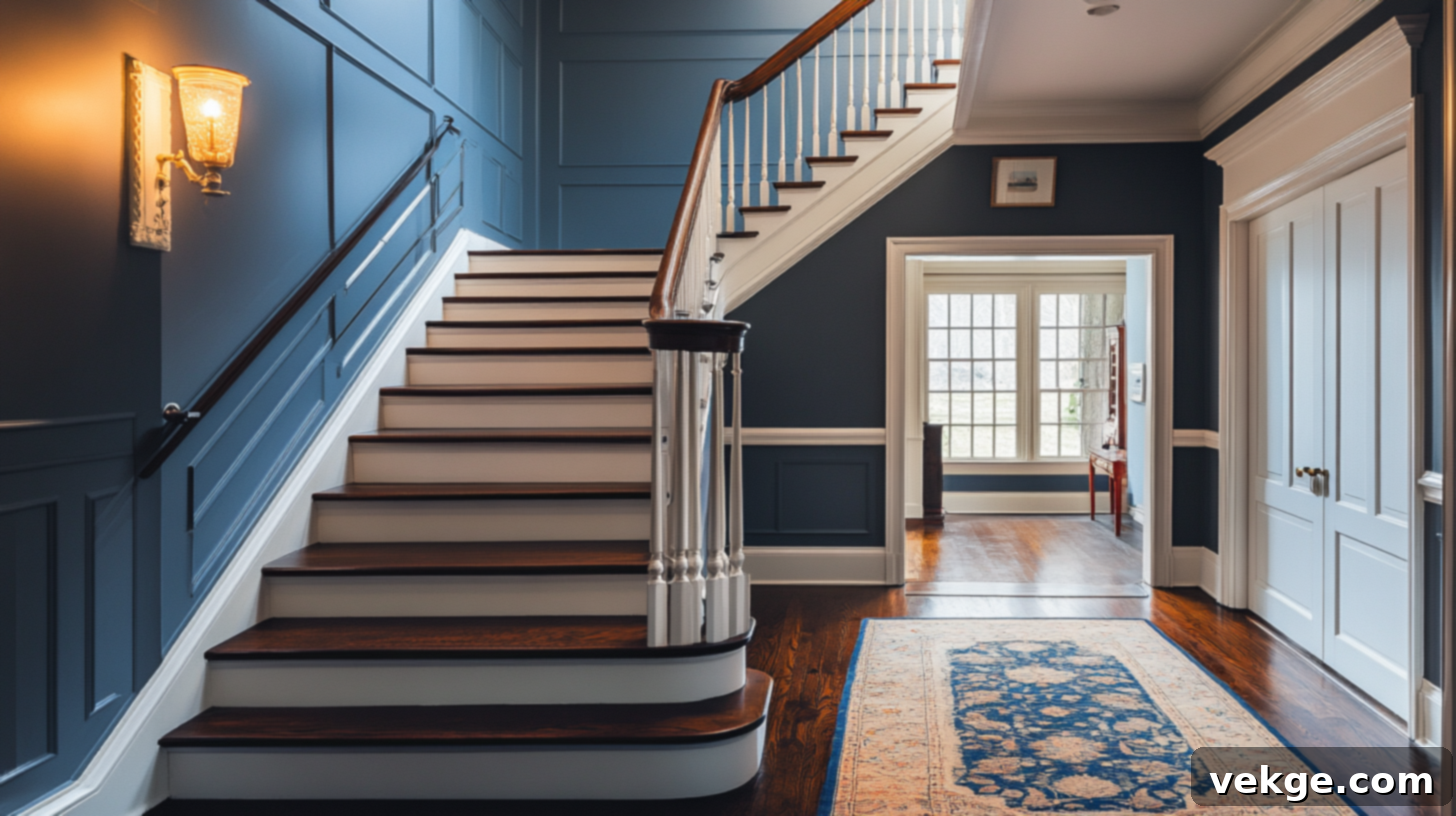
Infuse your home with old-world charm and intricate detailing by pairing dark wood treads with ornate white turned balusters and a complementary dark handrail. The distinctive curves, elaborate shapes, and craftsmanship of turned balusters harken back to historical periods, bringing a sense of artisanal heritage and decorative elegance to your staircase. The use of white for the balusters is crucial here, as it lightens the overall appearance and prevents the design from feeling overly heavy or dated. This sophisticated style is perfectly suited for older homes seeking to preserve their historical integrity or for new constructions aiming to replicate a classic, refined aesthetic. It introduces a touch of undeniable class and bespoke character without appearing ostentatious, creating a truly distinguished and inviting entryway.
11. Two-Landing Staircase with Gallery Wall

For more expansive entryways or architectural designs, a two-landing staircase offers both visual interest and practical comfort. Incorporate dark wood treads and white risers uniformly throughout all sections of the staircase, including the landings. The flat landing areas provide a welcome break during ascent or descent, enhancing comfort and breaking up the vertical climb. To add a personal and engaging touch, create a gallery wall along the adjacent staircase wall, showcasing a curated collection of family photos, artwork, or decorative mirrors. The dark treads create a cohesive flow that visually connects all parts of the staircase, while the gallery wall offers visual stimulation and a narrative element, turning a functional passage into a personalized journey through cherished memories and art.
12. Contrast Carpet Runner

Introduce an element of softness, warmth, and sound absorption to your dark wood staircase by adding a contrasting carpet runner. A deep gray, charcoal, or even black runner can beautifully complement the dark wood treads, providing a plush surface underfoot. The bright white risers play a vital role in this design, preventing the overall aesthetic from becoming too dark or enclosed, maintaining that crucial balance. The soft texture of the carpet runner not only feels pleasant and adds a layer of luxury but also significantly reduces noise from foot traffic, making your home quieter and more peaceful. This practical and stylish combination is ideal for busy households where the staircase sees heavy use. An added benefit is the ability to easily replace the carpet runner if it becomes worn or if you desire a change in décor, offering flexibility and long-term appeal.
13. Double L-Shaped Entry Stairs
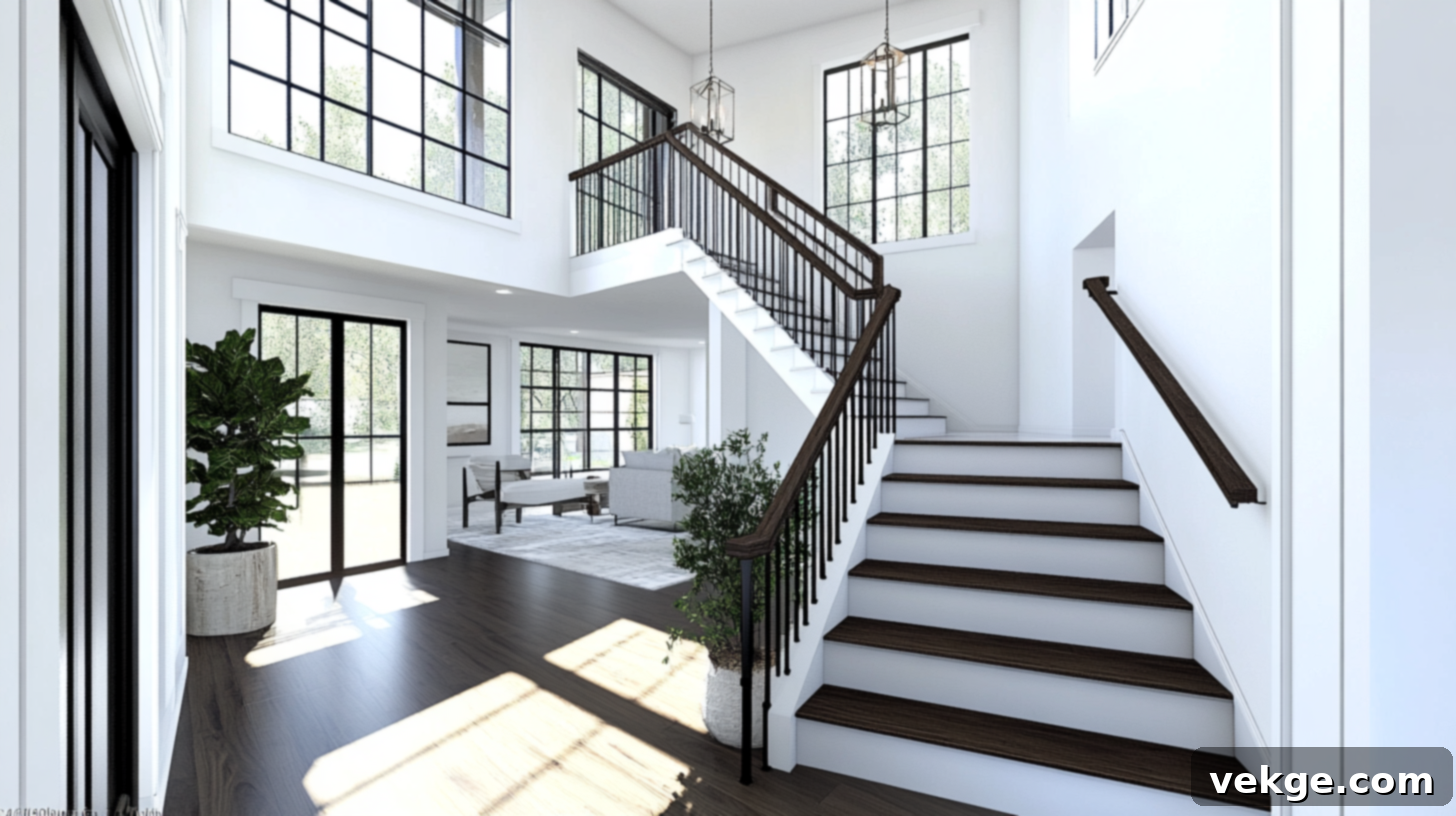
A double L-shaped staircase, characterized by two distinct turns, is an excellent space-saving solution compared to straight-run stairs, while still offering architectural grandeur. Apply the consistent theme of dark wood treads and bright white risers to all sections of this multi-directional staircase. The strategic turns in the staircase provide visual interest and natural resting points for the eyes, guiding them through the ascent. The sharp contrast between the dark and white elements ensures that even with its multiple sections and angles, the staircase maintains a cohesive and well-defined look, preventing it from appearing overly busy or fragmented. This design is particularly well-suited for homes with more compact footprints where maximizing space and creating visual depth are crucial, turning a necessity into a design opportunity.
14. Industrial Look with Metal Railing
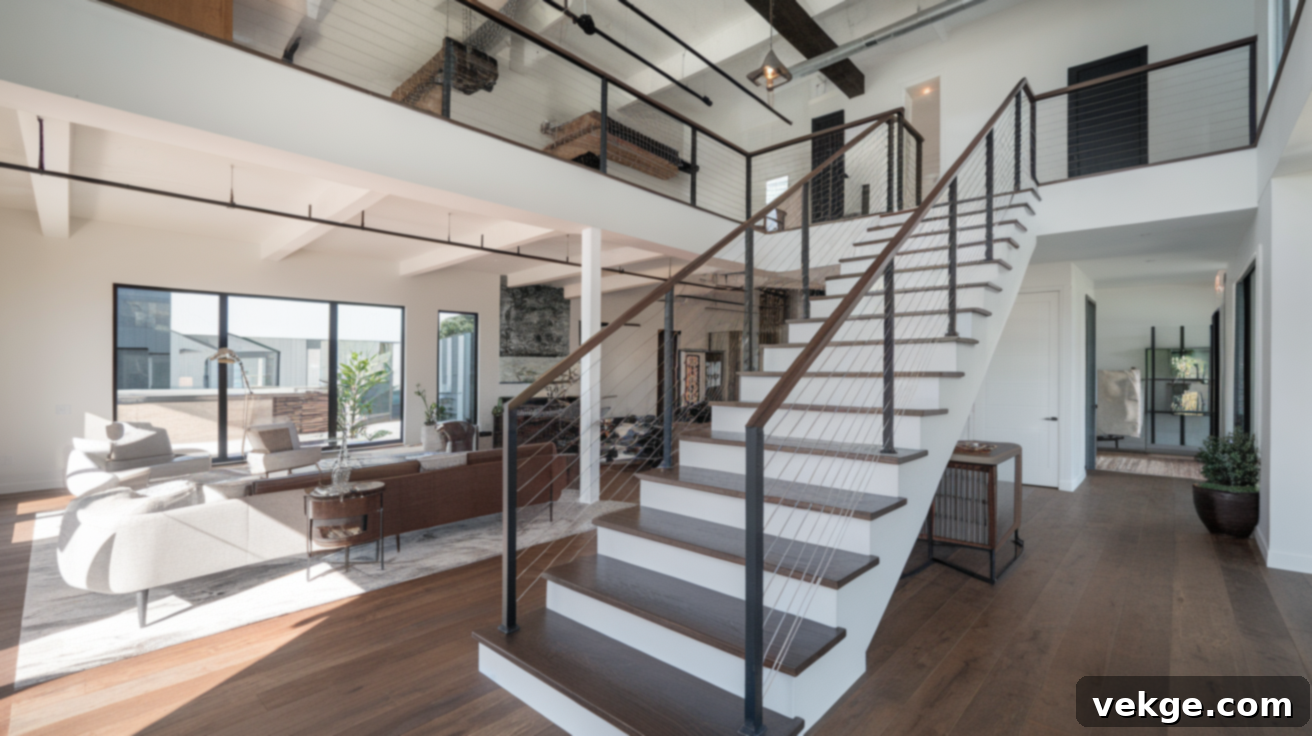
Embrace a chic urban aesthetic by combining the warmth of dark wood treads and the brightness of white risers with a contemporary metal railing system. Options include sleek steel cables, minimalist metal tubes, or industrial-style iron bars. This design evokes the raw, unrefined charm of a city loft or a modern factory conversion, making it a perfect fit for open-plan living spaces. The interplay of hard, resilient metal, the earthy tones of dark wood, and the clean crispness of white creates a bold yet inviting environment. This style harmonizes beautifully with other industrial elements within your home, such as exposed brick, concrete finishes, or metal light fixtures, creating a cohesive and cutting-edge interior that feels both robust and sophisticated.
15. Wide Treads for a Grand Entry
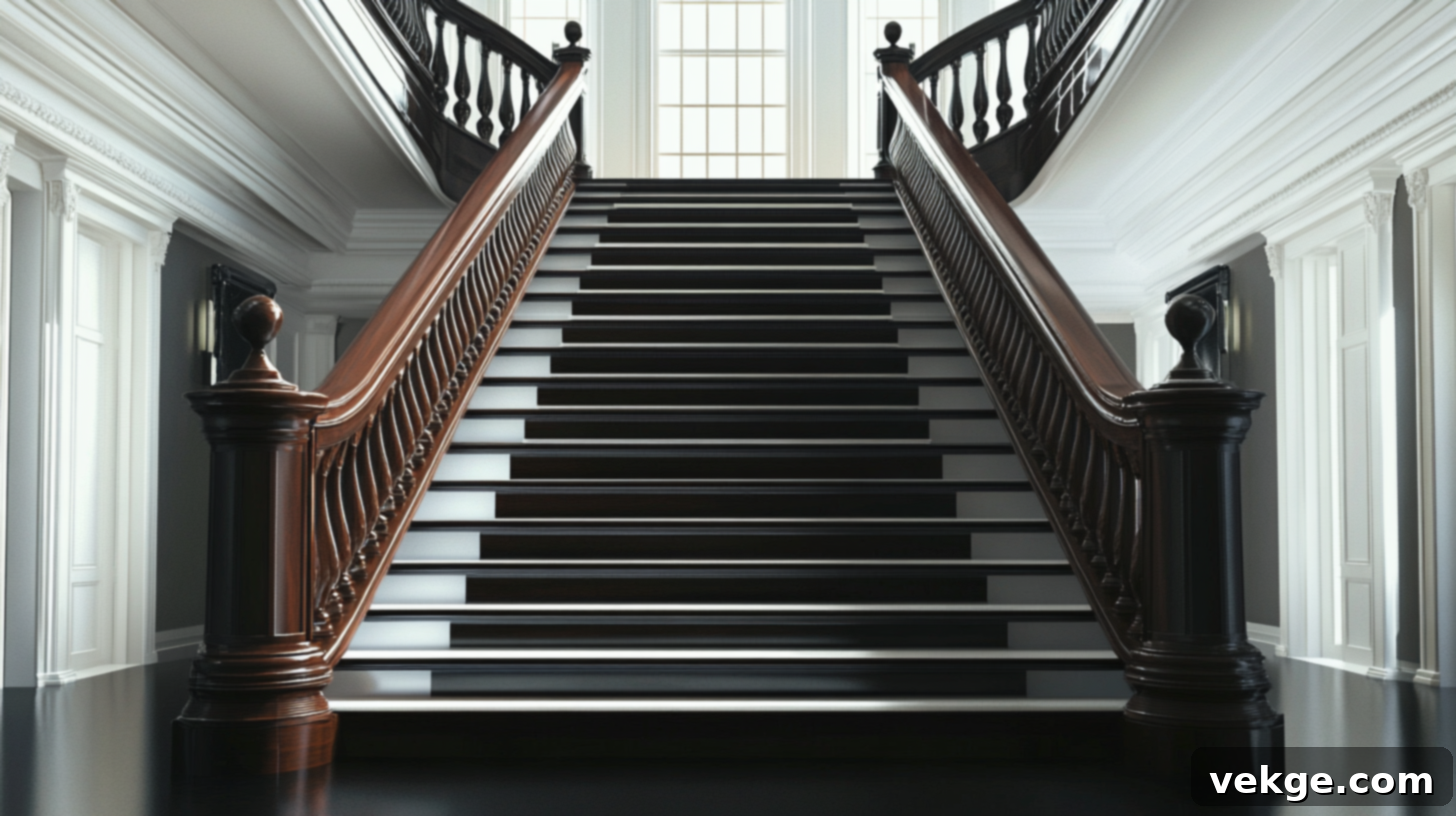
For homes with ample space and a desire for a truly impressive entrance, consider installing extra-wide dark wood treads paired with brilliant white risers and a substantial, often matching, wood handrail. The generous width of the steps creates a sense of luxury and calm, making the ascent feel more relaxed and deliberate. It also visually expands the entry area, imparting a feeling of grandeur and spaciousness. Crucially, the bright white risers counterbalance the considerable presence of the wide dark treads, ensuring the staircase doesn’t feel overly heavy or imposing. This design choice demands more floor space but delivers an undeniable ‘wow’ factor, making a magnificent first impression on guests. It’s ideally suited for larger homes or estates where a statement entryway is a key design objective, embodying elegance and scale.
16. Painted Risers with Stencil Patterns
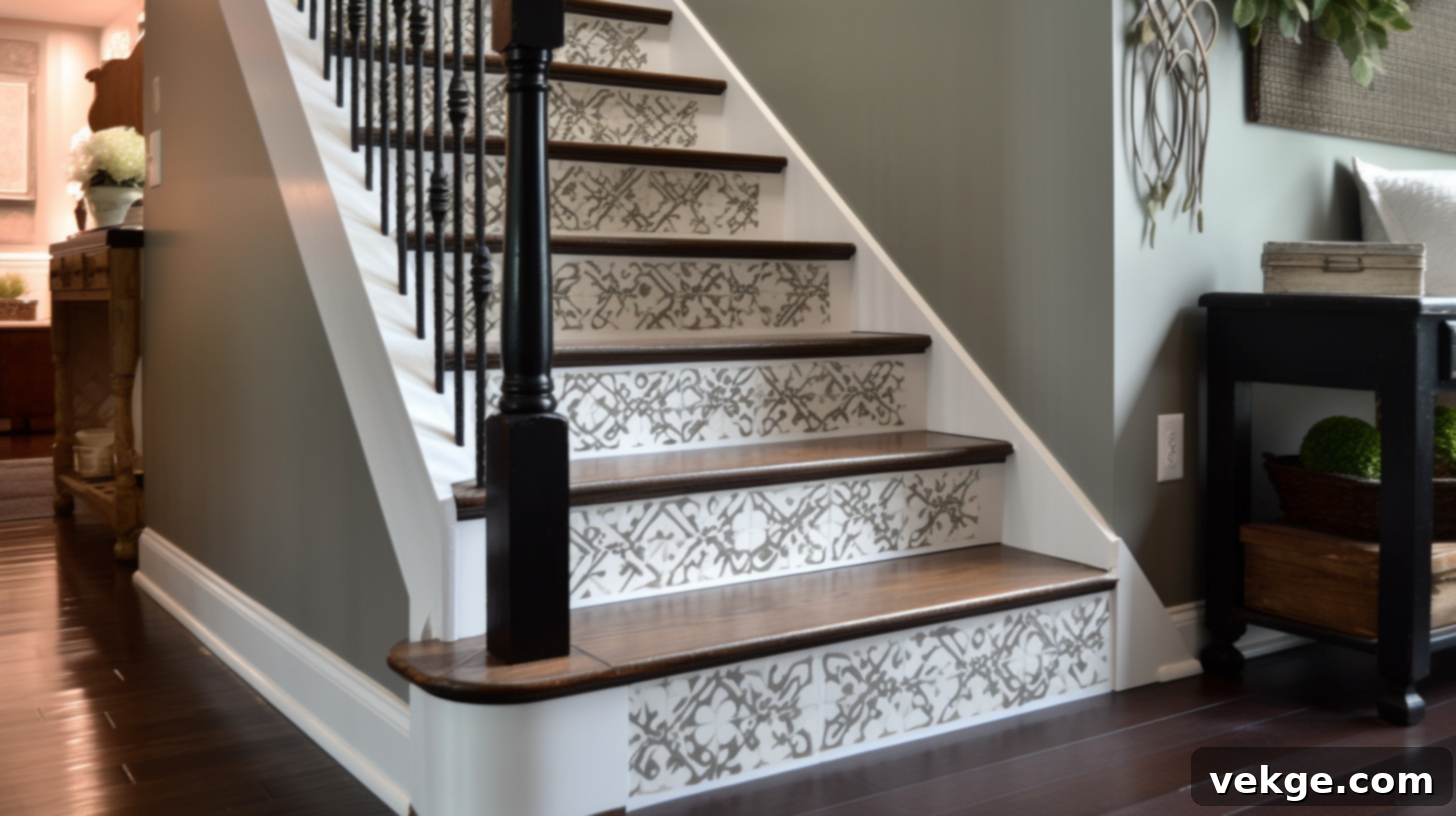
Inject a personalized touch and artistic flair into your staircase by adding subtle stencil patterns or decorative trim to the white risers. These custom designs, whether delicate gray geometric shapes, intricate floral motifs, or simple striped accents, can be as understated or as elaborate as your personal style dictates. The dark wood treads provide a strong, grounding foundation, beautifully complementing the more playful or artistic elements introduced on the white risers. This unique combination offers a fantastic opportunity to infuse your own creativity into a central feature of your home, creating a bespoke look that reflects your individuality. It works particularly well in homes that embrace an eclectic mix of vintage and contemporary styles, or those seeking a touch of whimsical charm that makes the staircase truly unique.
17. Stairs with Under-Tread Lighting

Elevate both the safety and sophistication of your staircase by installing discrete thin LED light strips beneath the lip of each dark wood tread. These strategically placed lights create a gentle, ambient glow that not only highlights the rich texture of the dark wood and the crispness of the white risers but also significantly enhances visibility and safety, especially during nighttime. The soft illumination lends a high-end, luxurious feel to even the simplest staircase designs, transforming it into a captivating architectural feature after dark. This practical yet elegant addition is versatile enough to complement various stair styles and is particularly beneficial for homes with children, elderly residents, or anyone seeking added security and a touch of modern luxury, making every step safer and more stylish.
18. Rustic Beam and Stair Combo

For a cohesive and warm rustic aesthetic, integrate your dark wood and white staircase with exposed wooden ceiling beams stained in a similar dark hue. This design strategy creates a unified look that ties the entire room together, from floor to ceiling. The substantial presence of the dark beams overhead beautifully complements the dark treads underfoot, while the bright white stair risers play a crucial role in breaking up the visual weight of all the dark wood, preventing the space from feeling too enclosed or dim. This style is particularly effective in homes that embrace a cabin, lodge, or modern farmhouse ambiance. The harmonious pairing of beams and stairs adds profound warmth, character, and architectural integrity to the entire living space, creating a truly inviting and cozy atmosphere.
19. Board and Batten Feature Wall
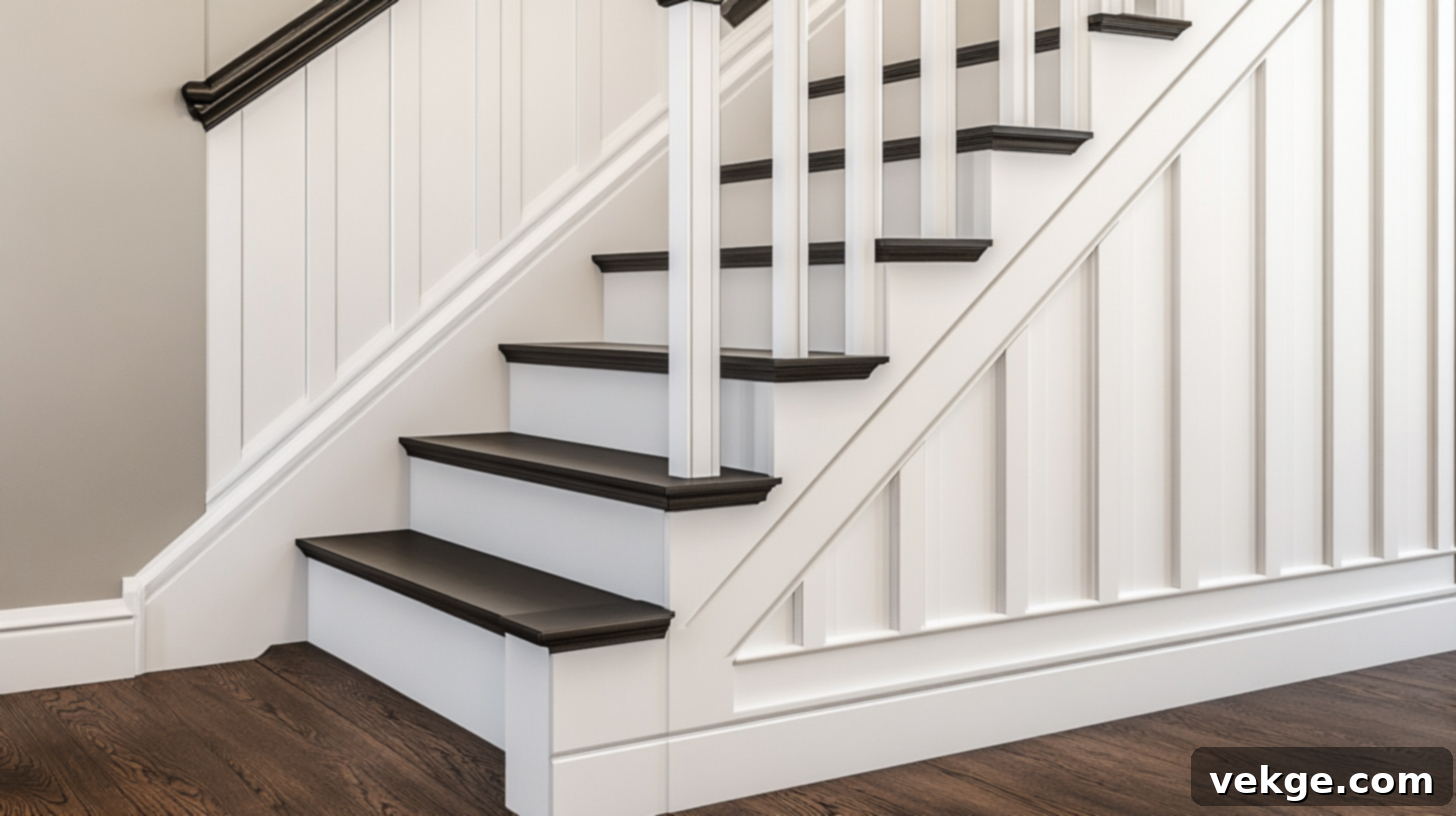
Create a striking and textured backdrop for your dark wood and white staircase by installing a board and batten feature wall in a clean white finish alongside it. This classic decorative paneling, characterized by thin wooden strips (battens) applied over a flat board surface, adds a distinct architectural dimension and subtle texture without introducing additional colors. The white board and batten wall works in perfect synergy with the white stair risers, collectively amplifying the brightness of the space and providing a pristine canvas against which the dark wood treads dramatically stand out. This style effortlessly brings a touch of sophisticated farm charm and timeless elegance to any home, ensuring the staircase area feels both open, bright, and deeply inviting, enhancing its overall visual appeal.
20. Open Stair Sides with Floating Look
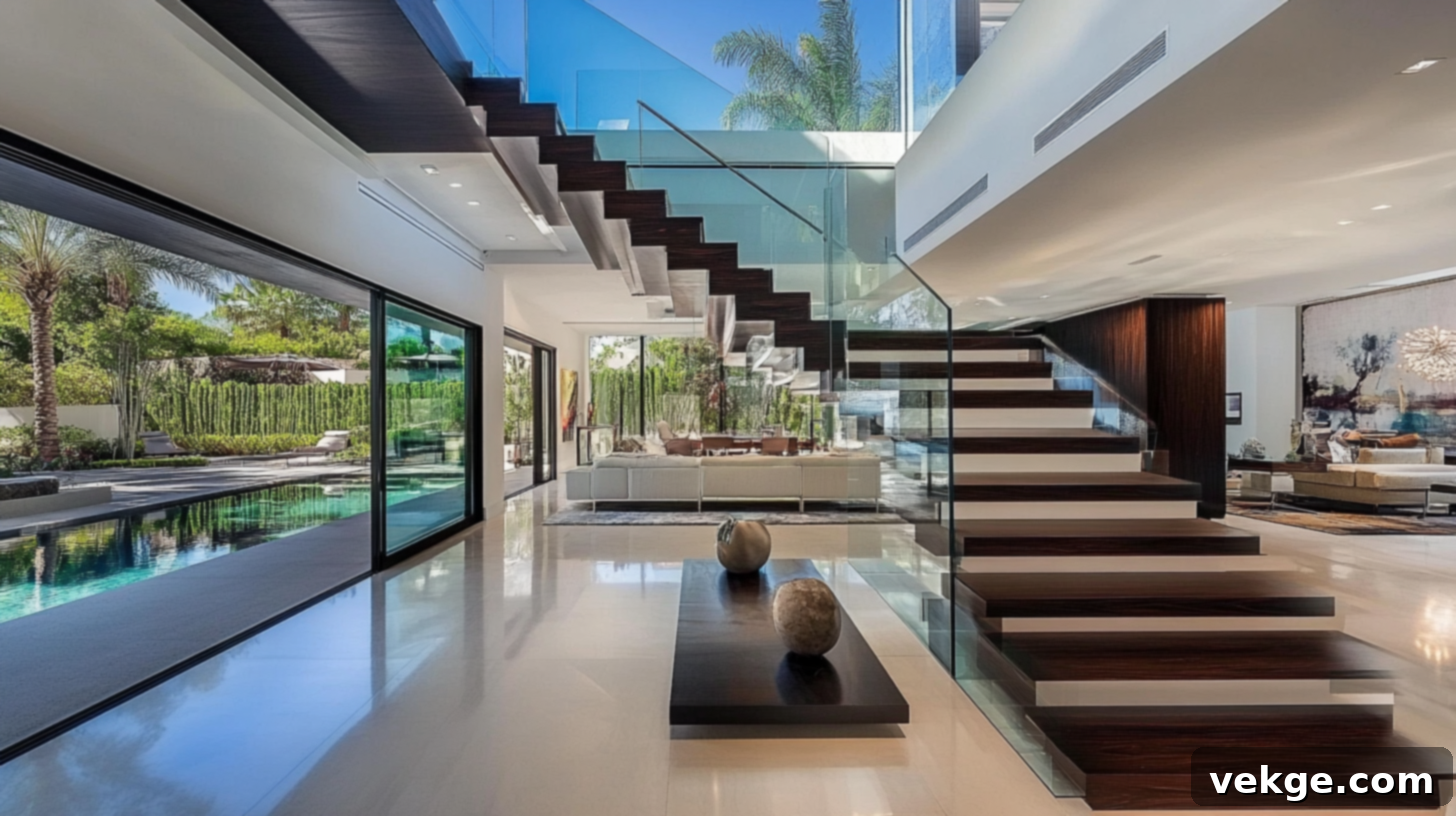
Maximize light and create an illusion of expansive space by designing your staircase with open sides or by lining them with clear glass panels. This approach allows only the substantial dark wood treads and crisp white risers to be prominently displayed, giving the entire structure a captivating floating appearance. The absence of traditional solid walls or heavy railings on the sides prevents the staircase from feeling enclosed, which is particularly beneficial in smaller areas or tight entryways. Light is free to penetrate through the open sides, actively brightening the surrounding space and enhancing the feeling of openness. This design is an excellent choice for modern homes, minimalist interiors, or any space where a clean, fresh, and airy aesthetic is desired, transforming a functional element into a work of art.
Step-by-Step DIY Guide: Achieving Dark Wood Treads with White Risers
This DIY project is an incredibly rewarding way to give your staircase a clean, bold, and dramatically updated look. The crisp white risers will instantly brighten your space, while the rich, dark treads will add warmth, depth, and that coveted high-contrast appeal. The best part? You don’t necessarily need to embark on an expensive full replacement; often, you can achieve this stunning transformation by simply refinishing what you already have. Follow this detailed guide to create a staircase that truly shines, enhancing your home’s value and aesthetic.
Tools & Materials Required
- Paint: Bright white, semi-gloss or satin finish for risers (durable, easy to clean, and provides a subtle sheen)
- Wood Stain: Dark shade of your choice (e.g., espresso, walnut, ebony) to achieve the desired rich tone
- Painter’s Tape: High-quality, essential for creating crisp, clean lines between painted and stained areas
- Sandpaper: 120-grit for initial sanding and stripping, 220-grit for fine smoothing and preparation for finish
- Wood Filler: (If needed) to repair any holes, cracks, or imperfections in the wood surface
- Paintbrushes: Angled brushes (1.5-2 inches) for detail work, corners, and edges on risers
- Foam Rollers: Small, high-density foam rollers (4-6 inches) for smooth, even paint application on flat riser surfaces
- Clean Cloths or Tack Cloth: For wiping dust after sanding and for applying/wiping off excess stain
- Polyurethane or Stair-Grade Sealant: For durable tread protection (water-based for quicker drying, oil-based for maximum durability; choose based on preference and expected traffic)
- Screwdriver: (If needed) to remove existing railings, balusters, or trim pieces for easier access and a cleaner finish
- Drop Cloths/Plastic Sheeting: To thoroughly protect floors, surrounding walls, and furniture from dust, paint, and stain
- Safety Gear: Gloves (latex or nitrile for painting/staining), dust mask (for sanding), safety glasses (for all steps involving tools or chemicals)
Step 1: Clear and Cover the Area
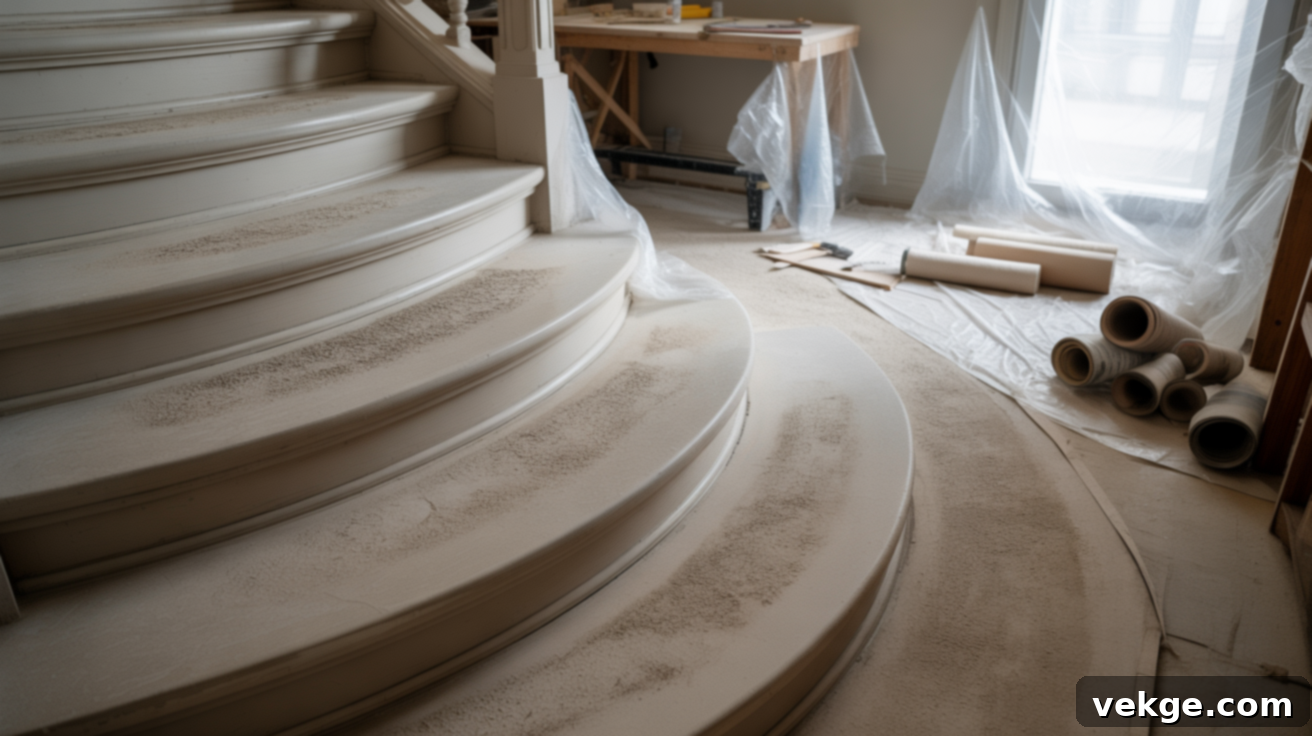
Begin by completely clearing your staircase. This means removing any existing carpet, stair runners, decorative trim pieces, or anything else that might obstruct your work. If your handrails, balusters, or newel posts are directly attached to the treads and need refinishing or removal for easier access, carefully detach them using a screwdriver or appropriate tools. Be sure to store all components and fasteners in a safe, labeled place for easy reinstallation later. Once the staircase is fully accessible and bare, lay down drop cloths or plastic sheeting to thoroughly cover the adjacent floor areas, nearby walls, and any furniture that could be exposed to dust, stain splatters, or paint drips. This crucial protection step minimizes cleanup and safeguards your home. Finally, give the entire staircase a good wipe-down with a dry rag or vacuum cleaner to remove all loose dirt, dust, and debris. A clean surface is absolutely paramount for optimal adhesion of paint and stain in the subsequent steps.
Step 2: Sand the Treads and Risers
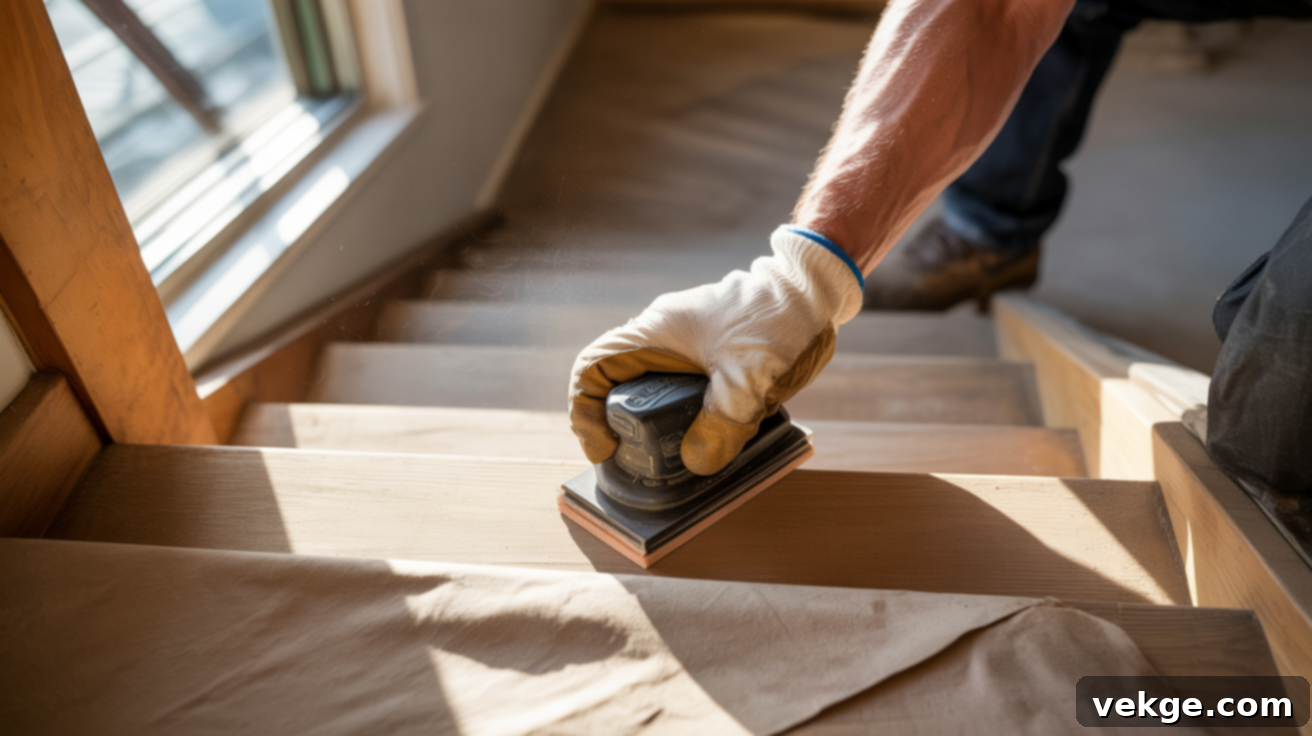
Sanding is arguably the most critical step for ensuring a professional and durable finish. Start with 120-grit sandpaper (either by hand, with an orbital sander for larger areas, or a detail sander for corners and edges) to thoroughly scuff the surface of both the treads and risers. Your goal here is to remove any old finish, existing gloss, minor imperfections, or rough patches, creating a uniform, dull surface that the new finishes can adhere to. Once the entire surface feels consistently smooth and even, switch to a finer 220-grit sandpaper to achieve a silky-smooth finish, which will allow for better absorption and a more refined look for both paint and stain. Carefully inspect each step for any small holes, dents, or fine cracks; fill these with wood filler, allow it to dry completely according to manufacturer instructions, and then sand those specific areas again until they are perfectly flush with the surrounding surface. After all sanding is complete, meticulously clean the entire staircase with a tack cloth or a slightly damp rag to remove every trace of sanding dust. Skipping this step can lead to a grainy finish or poor adhesion of your paint and stain.
Step 3: Tape the Edges Precisely
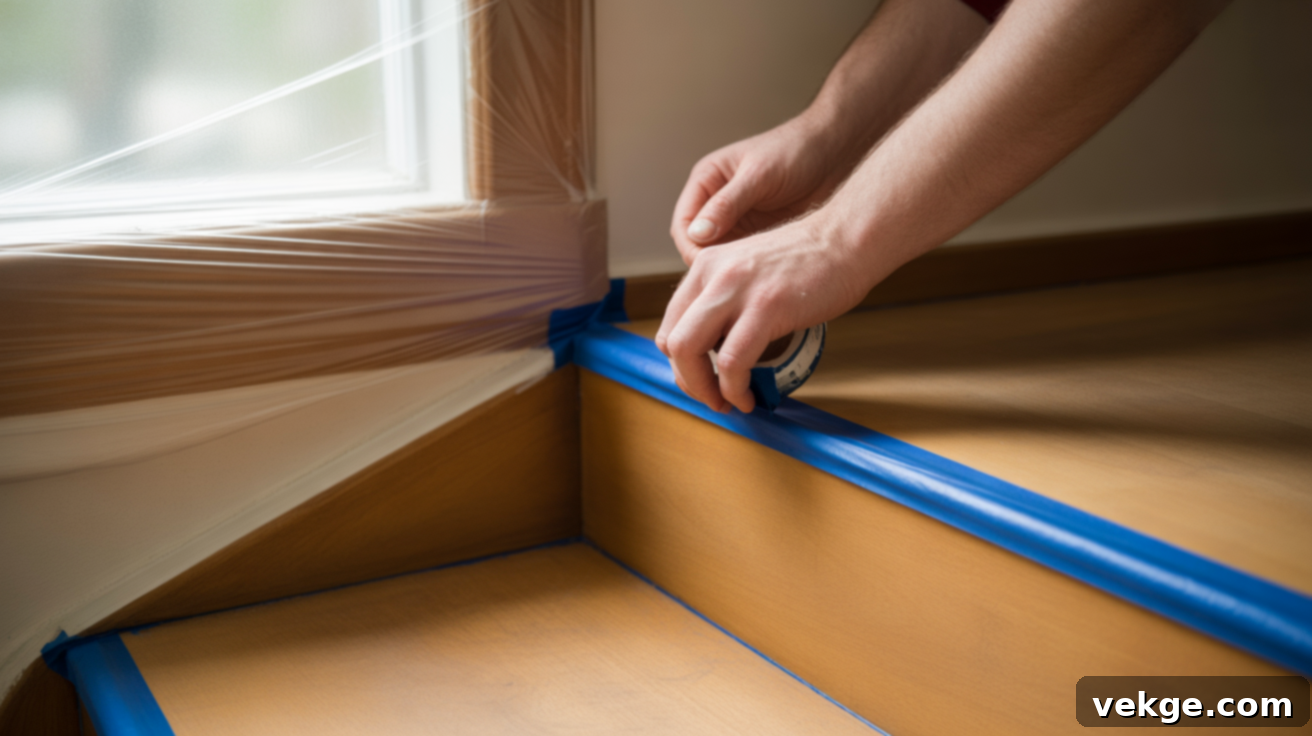
With your surfaces perfectly prepped, it’s time to define the crisp lines that will give your staircase its signature high-contrast look. Carefully apply high-quality painter’s tape along every precise edge where the dark wood treads will meet the white risers. Additionally, tape off the sides of the staircase where it meets the walls or baseboards to protect them from any accidental drips or smudges. Precision is key here: press the tape down very firmly along its entire length, ensuring there are no gaps or air bubbles where paint or stain could bleed underneath. Taking your time on this step will pay dividends, as sharp, neat lines are fundamental to a professional-looking final result and will truly make your hard work shine. If you are also refinishing the handrail or any side trim, be sure to tape off those areas as well to keep them distinct from the main treads and risers, maintaining a clean aesthetic.
Step 4: Paint the Risers
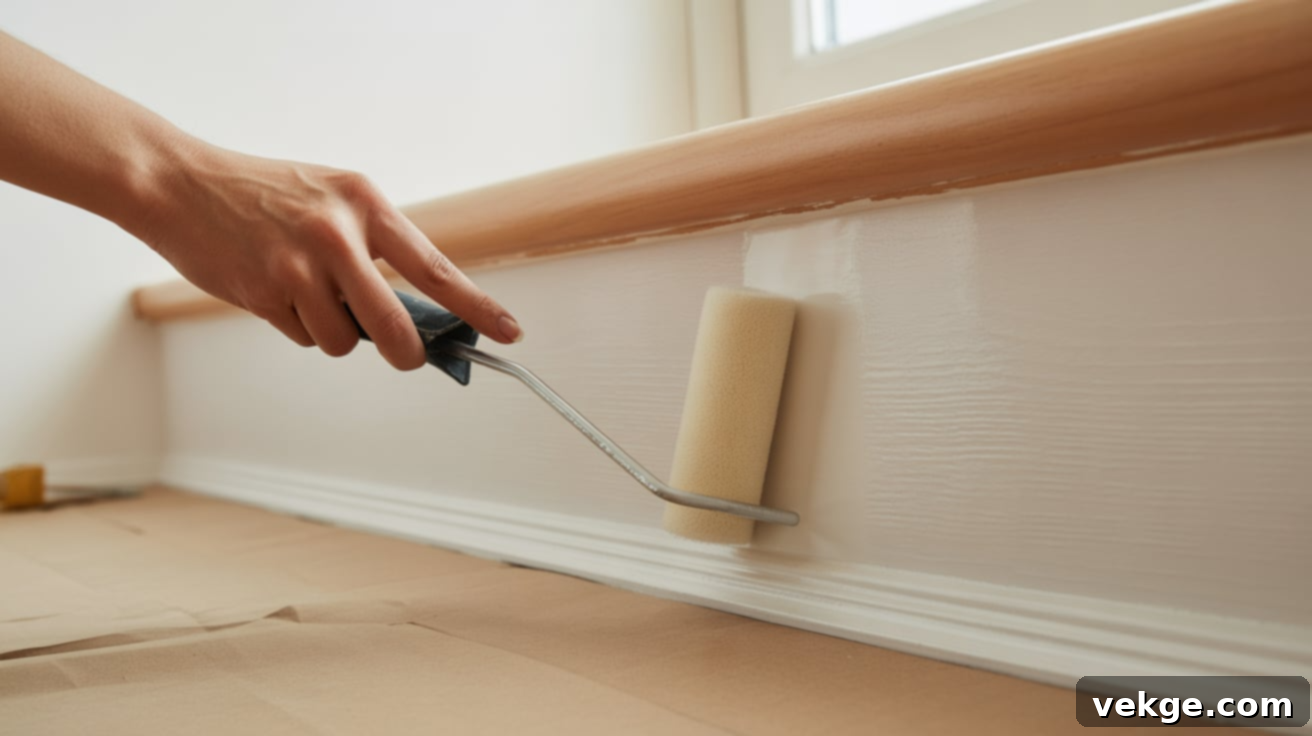
Begin by painting the white risers first. This allows the paint ample time to dry and cure while you move on to staining the treads, preventing any accidental smudges. Using an angled brush for corners and edges, and a small, high-density foam roller for the larger flat surfaces, apply the white paint in smooth, even strokes. For risers, semi-gloss or satin finishes are highly recommended as they are much more durable and significantly easier to clean than matte finishes, which is important for a high-traffic area prone to scuff marks. Start with a thin, light coat to prevent drips and ensure even coverage, allowing it to dry completely as per the paint manufacturer’s instructions. Apply a second coat for solid, opaque coverage, and if the original color or wood grain still shows through, a third coat may be necessary. Always allow each coat to dry thoroughly before applying the next, and continuously inspect for any thick spots or uneven patches, smoothing them out while the paint is still wet to achieve a flawless, streak-free finish.
Step 5: Stain the Treads
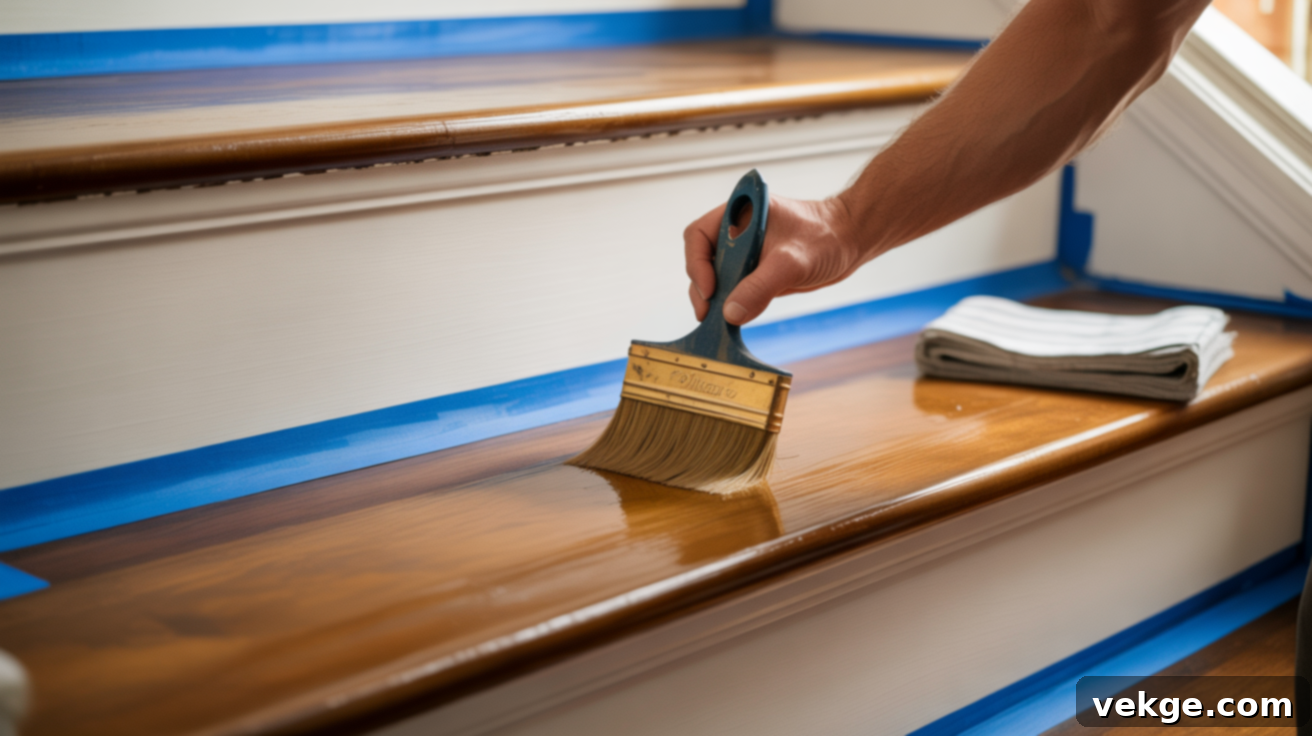
Once your painted risers are completely dry and cured, it’s time to transform the treads. Stir your chosen wood stain thoroughly before and during use to ensure consistent color. Work on one step at a time to manage the application effectively. Apply the stain generously using a clean cloth, foam brush, or natural bristle brush, moving in the direction of the wood grain. Immediately after application, wipe off any excess stain with a clean, lint-free cloth. This “wipe on, wipe off” technique prevents blotchiness, controls the depth of color, and allows the natural wood grain to show through beautifully. Let the first coat dry completely according to the stain manufacturer’s recommendations. If you desire a deeper, richer color, apply a second coat after the first has dried, following the same application and wiping technique. It’s crucial to protect your freshly painted white risers; use painter’s tape or a piece of cardboard as a shield while staining the treads to prevent any overlap. Once the stain is completely dry (usually 24-48 hours depending on product), you can lightly sand the surface with 220-grit sandpaper to create a smooth base for your sealant. Wipe away all dust with a tack cloth, then apply two to three coats of a high-quality polyurethane or stair-grade sealant to protect the wood from wear and tear. Allow each coat to dry fully, sanding lightly between coats for the best finish. Ensure the final coat cures for at least 24-48 hours before subjecting the stairs to heavy foot traffic.
Step 6: Remove Tape and Final Touches
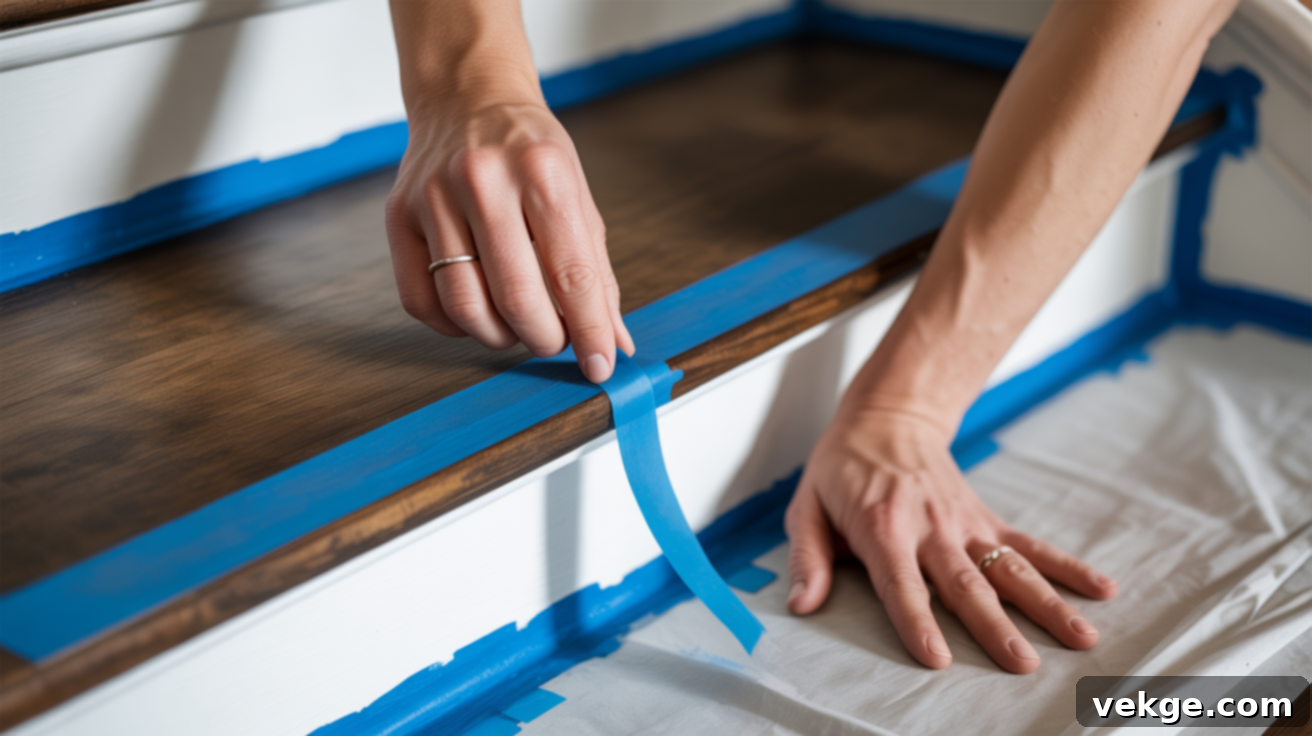
Once all paint and stain coats are thoroughly dry and the final sealant has completely cured (this is crucial to avoid lifting or smudging), carefully and slowly peel off the painter’s tape. Pull the tape at a low angle, away from the freshly finished surfaces, to minimize the risk of pulling up any paint along with it. Should you notice any minor bleeding or spots where paint or stain may have seeped under the tape, use a small, fine-tipped artist’s brush and a tiny amount of the appropriate paint or stain to meticulously touch up these imperfections. Reattach any trim, railings, or newel posts that you removed earlier, ensuring they are securely fastened and stable before the stairs are used. This final, meticulous step brings your entire staircase project to a polished conclusion, making it look expertly finished and crafted with care, ready to be a stunning centerpiece in your home for years to come.
Finished Look
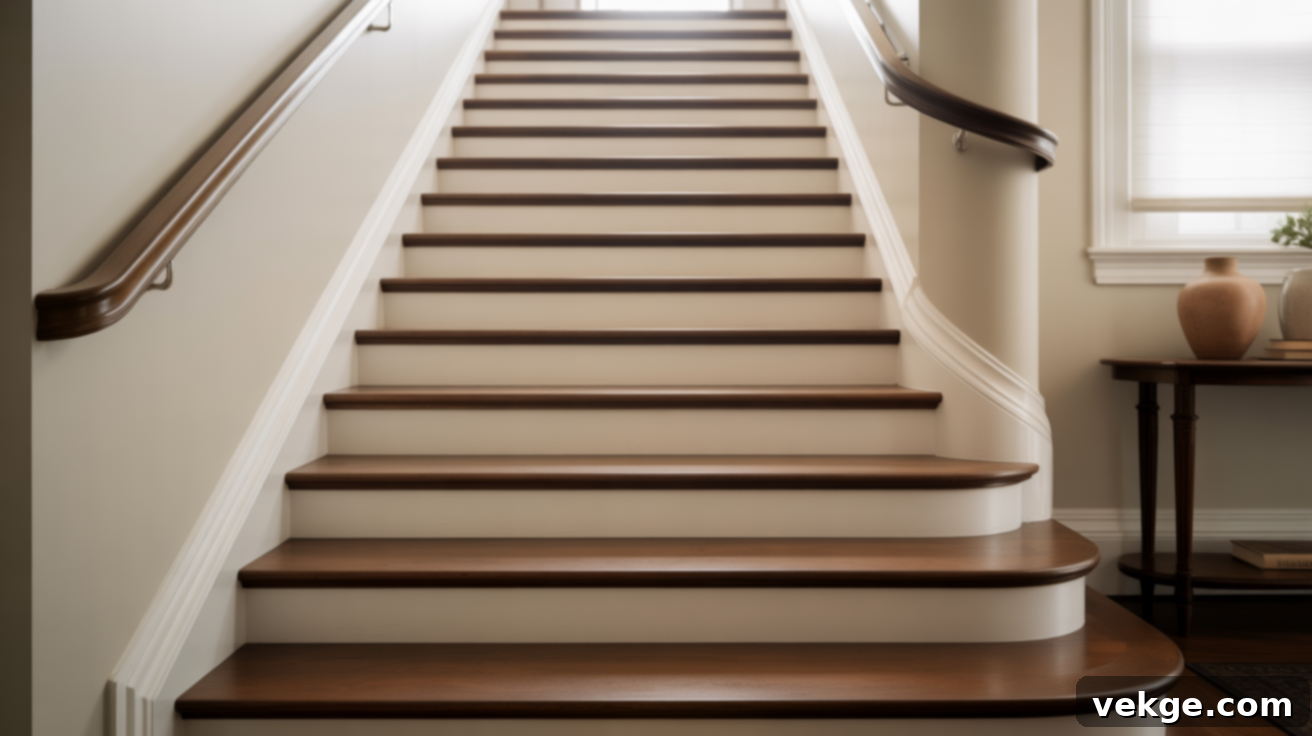
Congratulations! Your DIY project is now complete. Step back and admire your transformed staircase, featuring rich, elegant dark treads and impeccably clean white risers. The lines where the paint meets the stain should be sharp, crisp, and professional-looking, highlighting the beautiful contrast you’ve created. Everything is sealed, thoroughly dry, and ready for daily use, providing a safe and stunning passage. With all trim and railings reinstalled and the surrounding area pristine, your staircase stands as a testament to your hard work and attention to detail. This final result beautifully demonstrates how a thoughtful and relatively simple update can dramatically alter the ambiance and aesthetic appeal of your entire living space, turning a functional element into a dazzling focal point and a true reflection of your style.
Maintenance Tips for Lasting Beauty
To ensure your stunning dark wood and white staircase retains its striking appearance and withstands the test of time, consistent and appropriate maintenance is key. While the dark wood offers durability and camouflages minor imperfections, the white risers will demand a bit more attention to stay bright and pristine, preserving the overall high-contrast effect.
- Regular Cleaning of Risers: Frequently wipe down white risers with a mild soap solution (like diluted dish soap or a gentle all-purpose cleaner) and a soft, damp cloth. This helps remove shoe scuffs, dust, and general grime that can quickly dull their bright appearance. Avoid abrasive cleaners or scouring pads that could scratch or damage the paint finish.
- Wood Tread Care: For the dark wood treads, use a wood-specific cleaner or furniture polish designed for stairs. Apply with a soft, lint-free cloth, moving with the grain, to clean and nourish the wood. Avoid excessive water, which can damage wood over time, and ensure any spills are wiped immediately.
- Prevent Scratches: Implement preventative measures to protect your dark wood from scratches and dents. Place felt pads on the legs of any furniture or decorative items near the stairs, and encourage family members and guests to remove shoes, especially those with hard or sharp soles or heels, before ascending.
- Consider Runners: In high-traffic areas, consider installing a stylish stair runner. Not only does it add a layer of aesthetic appeal, comfort underfoot, and improved traction, but it also significantly reduces wear and tear on your dark wood treads, extending their lifespan and maintaining their pristine look.
- Annual Paint Touch-Ups: Inspect your white risers annually for any chips, scuffs, or discoloration. A quick touch-up with matching white paint can keep them looking fresh and new, preventing small imperfections from growing and preserving the clean, bright aesthetic.
- Wood Scratch Repair: For minor scratches on dark wood treads, consider using wood touch-up markers or stain pens that closely match your wood’s shade. For deeper scratches, specialized wood repair kits that include fillers and color-matching compounds can effectively conceal and repair the damage.
- Dust Regularly: Dust both treads and risers frequently (at least once a week) with a microfiber cloth or a soft brush attachment on your vacuum cleaner. This prevents the accumulation of dust and pet hair, which can make white risers look dingy and dull the natural shine of dark wood.
- Protect from Sun: If your staircase is exposed to direct sunlight for extended periods, consider installing UV-blocking window treatments or blinds. This will help protect the wood stain from fading and the paint from yellowing over time, preserving your staircase’s vibrant contrast.
Wrapping Up Your Staircase Transformation
The timeless combination of dark wood stairs with crisp white risers offers an unparalleled opportunity to dramatically upgrade your home’s aesthetic and enhance its overall appeal. Whether your vision involves a subtly refined design or a bold statement replete with special features like hidden lighting or custom patterns, this classic duo consistently delivers a sophisticated and enduring look that integrates beautifully into virtually any interior design scheme, instantly elevating the entire space.
With just a few thoughtful changes – often achievable through a rewarding DIY approach – your ordinary staircase can be transformed into an extraordinary feature that is both highly functional and exquisitely beautiful. Feeling inspired to begin this exciting project in your own home? Don’t hesitate! Start with the foundational steps: a fresh, vibrant coat of white paint on your risers and a rich, deep wood stain on the treads. From there, you can explore adding a plush runner for an extra layer of comfort and noise reduction, or perhaps incorporate discreet under-tread lighting to create a luxurious and safe ambiance after dark, making your stairs a true highlight.
Remember that sustained beauty comes with consistent care. By adhering to simple, regular cleaning routines and addressing minor wear promptly, you can ensure your transformed staircase remains a stunning focal point and a source of pride for many years to come. With the wealth of ideas and the detailed DIY guidance provided in this article, you are now equipped to turn an everyday passageway into a standout architectural feature that not only connects levels but also elevates the entire atmosphere and value of your home!
